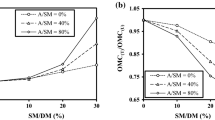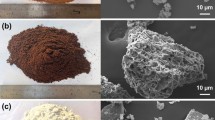Abstract
Polyurethane is one of the polymers used in recent years for the production of thermal insulators. The aim of the present study was to optimize the heat transfer of polyurethane foam using clay nanoparticles and microparticles from polypropylene waste using central composite design of the response surface methodology with the help of Design-Expert V.11 software. For this purpose, the effect of three independent variables of thickness (0.5–1.5 cm), amount of clay nanoparticles (0–2%), and amount of polypropylene wastage microparticles (0–2%) was investigated. A 2-factor model (2FI) was presented for correlation between independent variables for maximum reduction in heat transfer under optimal conditions. Thermal insulation properties were determined using a heat flow meter according to standard method American Society for Testing and Materials C518-17. Morphological properties of the produced composites were determined using SEM image analysis and MATLAB software. The results showed that the composites with the thickness of 1 cm, containing 2% nanoclay and 1% polypropylene, and composites with the thickness of 1.25 cm, containing 1.5% nanoclay and 1.5% polypropylene with 0.045 thermal conductivity have the best performance in terms of thermal insulation and have a 22–26% better performance than pure polyurethane foam. With the increase in percentage of polypropylene and nanoclay, the thermal conductivity decreased. The results of the study showed that fillers could be used to enhance the thermal insulation properties.






Similar content being viewed by others
References
Abbaspour M, Jafari MJ, Mansouri N, Moattar F, Nouri N, Allahyari M (2008) Thermal comfort evaluation in Tehran metro using Relative Warmth Index. Int J Environ SciTechnol 5:297–304. https://doi.org/10.1007/BF03326024
Al-Homoud MS (2005) Performance characteristics and practical applications of common building thermal insulation materials. Build Environ 40:353–366
Arabgol F, Kokabi M, Bahramian AR (2013) Effect of Nanoclay on mechanical properties and ablation behavior of a nitrile-based heat insulator. SciTechnol 25:449–458
Badamshina E, Estrin Y, Gafurova M (2013) Nanocomposites based on polyurethanes and carbon nanoparticles: preparation, properties and application. J Mater Chem A 1:6509–6529
Batra U, Singhal S (2017) Optimum level of insulation for energy efficient envelope of office buildings. Int J Environ SciTechnol 14:2389–2398. https://doi.org/10.1007/s13762-017-1322-2
Berardi U, Madzarevic J (2020) Microstructural analysis and blowing agent concentration in aged polyurethane and polyisocyanurate foams. ApplThermEng 164:114440
Chang K-J et al (2014) Preparation of silica aerogel/polyurethane composites for the application of thermal insulation. J Polym Res 21:338
Chen L, Rende D, Schadler LS, Ozisik R (2013) Polymer nanocomposite foams. J Mater Chem A 1:3837–3850
Chikhi M, Agoudjil B, Boudenne A, Gherabli A (2013) Experimental investigation of new biocomposite with low cost for thermal insulation. Energy Build 66:267–273
Çomaklı K, Yüksel B (2003) Optimum insulation thickness of external walls for energy saving. ApplThermEng 23:473–479
Crowe J, de Joode BVW, Wesseling C (2009) A pilot field evaluation on heat stress in sugarcane workers in Costa Rica: What to do next? Global Health Action 2:2062
Dehghan SF, Golbabaei F, Maddah B, Latifi M, Pezeshk H, Hasanzadeh M, Akbar-Khanzadeh F (2016) Optimization of electrospinning parameters for polyacrylonitrile-MgOnanofibers applied in air filtration. J Air Waste ManagAssoc 66:912–921
Gayathri R, Vasanthakumari R, Padmanabhan C (2013) Sound absorption, thermal and mechanical behavior of polyurethane foam modified with nano silica, nano clay and crumb rubber fillers. Int J Sci Eng Res 4:301–308
Han Z, Chunsheng L, Kombe T, Thong-On N (2008) Crumb rubber blends in noise absorption study. Mater Struct 41:383–390
Hong Z, Bo L, Guangsu H, Jia H (2007) A novel composite sound absorber with recycled rubber particles. J Sound Vibration 304:400–406
Kaynakli O (2012) A review of the economical and optimum thermal insulation thickness for building applications. Renew Sustain Energy Rev 16:415–425
Kostrzewa M, Bakar M, Białkowska A, Szymańska J, Kucharczyk W (2019) Structure and properties evaluation of epoxy resin modified with polyurethane based on polymeric MDI and different polyols. PolymPolym Compos 27:35–42
Mahfuz H, Rangari VK, Islam MS, Jeelani S (2004) Fabrication, synthesis and mechanical characterization of nanoparticles infused polyurethane foams. Compos Part A Appl Sci Manuf 35:453–460
Mahlia T, Taufiq B, Masjuki H (2007) Correlation between thermal conductivity and the thickness of selected insulation materials for building wall. Energy Build 39:182–187
Mechanics AISDoR (2008) Standard test method for determination of thermal conductivity of soil and soft rock by thermal needle probe procedure. ASTM International, Pennsylvania
Modesti M, Lorenzetti A, Besco S (2007) Influence of nanofillers on thermal insulating properties of polyurethane nanocomposites foams. PolymEngSci 47:1351–1358
Nassiri P, Monazzam MR, Golbabaei F, Farhang Dehghan S, Shamsipour A, Ghanadzadeh MJ, Asghari M (2020) Modeling heat stress changes based on wet-bulb globe temperature in respect to global warming. J Environ Health Sci Eng 18:441–450
RoohalahHajizadeh AK, Barmar M, Jafari AJ, Dehghan SF (2019) Improving the sound absorption properties of flexible polyurethane (PU) foam using nanofibers and nanoparticles. Sound Vib 53:208–222
Septevani AA, Evans DA, Annamalai PK, Martin DJ (2017) The use of cellulose nanocrystals to enhance the thermal insulation properties and sustainability of rigid polyurethane foam. Ind Crops Prod 107:114–121
Verdejo R, Stämpfli R, Alvarez-Lainez M, Mourad S, Rodriguez-Perez M, Brühwiler P, Shaffer M (2009) Enhanced acoustic damping in flexible polyurethane foams filled with carbon nanotubes. Compos SciTechnol 69:1564–1569
Verdolotti L, Di Caprio MR, Lavorgna M, Buonocore GG (2017) Polyurethane nanocomposite foams: correlation between nanofillers, porous morphology, and structural and functional properties. In: Thomas S, Datta J, Haponiuk J, Reghunadhan A (eds) Polyurethane polymers. Elsevier, Amsterdam, pp 277–310
Wang S-X, Zhao H-B, Rao W-H, Huang S-C, Wang T, Liao W, Wang Y-Z (2018) Inherently flame-retardant rigid polyurethane foams with excellent thermal insulation and mechanical properties. Polymer 153:616–625
Wi S, Berardi U, Di Loreto S, Kim S (2020) Microstructure and thermal characterization of aerogel–graphite polyurethane spray-foam composite for high efficiency thermal energy utilization. J Hazard Mater 397:122656. https://doi.org/10.1016/j.jhazmat.2020.122656
Widya T, Macosko CW (2005) Nanoclay-modified rigid polyurethane foam Journal of Macromolecular Science. Part B Phys 44:897–908
Yan D, Xu L, Chen C, Tang J, Ji X, Li Z (2012) Enhanced mechanical and thermal properties of rigid polyurethane foam composites containing graphene nanosheets and carbon nanotubes. PolymInt 61:1107–1114
Yucel K, Basyigit C, Ozel C Thermal insulation properties of expanded polystyrene as construction and insulating materials. In: 15th Symposium in Thermophysical Properties, 2003. PP. 54–66
Zach J, Hroudová J, Brožovský J, Krejza Z, Gailius A (2013) Development of thermal insulating materials on natural base for thermal insulation systems. ProcEng 57:1288–1294
Zhang B, Poon CS (2015) Use of furnace bottom ash for producing lightweight aggregate concrete with thermal insulation properties. J Clean Prod 99:94–100
Zhang H, Fang W-Z, Li Y-M, Tao W-Q (2017) Experimental study of the thermal conductivity of polyurethane foams. ApplThermEng 115:528–538
Acknowledgement
This work was financially supported by the Baqiyatallah University of Medical Sciences (Grant No. 97000583).
Author information
Authors and Affiliations
Corresponding author
Ethics declarations
Conflict of interest
The authors declare that there are no conflicts of interest.
Ethics approval
Ethical approval for this study was obtained from the ethical committee of Baqiyatallah University of Medical Sciences (IR.BMSU.REC.1398.084).
Additional information
Editorial responsibility: Samareh Mirkia.
Rights and permissions
About this article
Cite this article
Valipour, F., Dehghan, S.F. & Hajizadeh, R. The effect of nano- and microfillers on thermal properties of Polyurethane foam. Int. J. Environ. Sci. Technol. 19, 541–552 (2022). https://doi.org/10.1007/s13762-021-03150-3
Received:
Revised:
Accepted:
Published:
Issue Date:
DOI: https://doi.org/10.1007/s13762-021-03150-3




